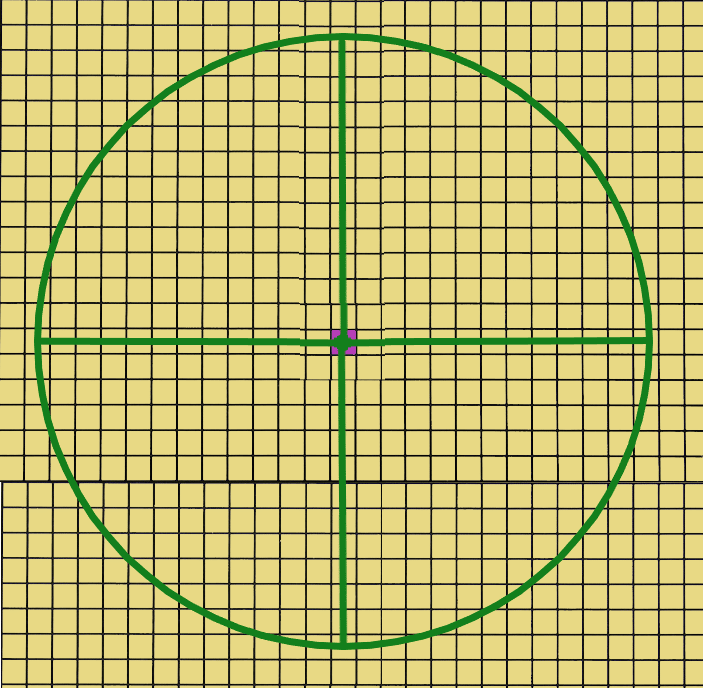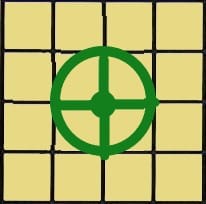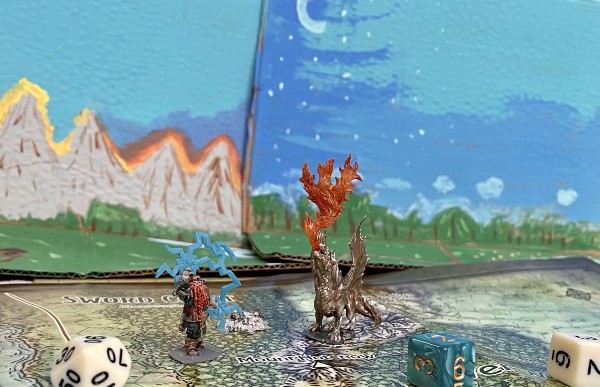When you cast the spell, choose a point you can see under the cloud. A bolt of lightning flashes down from the cloud to that point. Each creature within 5 feet of that point must make a Dexterity saving throw. A creature takes 3d10 lightning damage on a failed save, or half as much damage on a successful one. On each of your turns until the spell ends, you can use your action to call down lightning in this way again, targeting the same point or a different one.
If you are outdoors in stormy conditions when you cast this spell, the spell gives you control over the existing storm instead of creating a new one. Under such conditions, the spell’s damage increases by 1d10.
At Higher Levels. When you cast this spell using a spell slot of 4th or higher level, the damage increases by 1d10 for each slot level above 3rd.
Casting Time: 1 action
Range: 120 feet
Components: V, S
Duration: Concentration, up to 10 minutes
School: 3rd-level conjuration
Player’s Handbook, pg. 220
Call Lightning 5e
Call Lightning — the Dungeons and Dragons spell that can light up the sky and fry up your enemies from afar. This thunderbolt artillery cannon is a ton of fun to use, even if it does have some strict requirements to cast.
We’ll go over all the spell’s rules and applications, as well as tips for DMs who want take a crack at using Call Lightning themselves.
Who Can Cast Call Lightning in 5e?
The following classes have Call Lightning on their spell list:
-
Druid
The following subclasses get Call Lightning for free:
-
Druid (Circle of the Land: Forest)
-
Cleric (Tempest Domain)
What Does Call Lightning Do in 5e?
Call Lightning creates a 60-foot radius storm cloud anywhere above the caster. On the turn they cast it, they can send a lightning bolt down onto a point below the storm cloud that forces a Dexterity saving throw for all creatures within 5 feet of the point.
Creatures who fail take 3d10 lightning damage, while those who pass take half as much.
On subsequent turns, the caster can use their action to call lightning in this way again, and may choose a new point (although it still must be below the storm cloud, which is stationary).
If the natural weather is stormy, the damage increases by 1d10. Call Lightning can also be upcast for 1d10 per slot level above 3rd.
Let’s quickly go over how Call Lightning’s area of effect and range work. For starters, here’s an image of the spell’s total area of effect:

The purple square is where the caster is standing; the small green circle is the point on which the spell is centered; the large green circle represents the area that the cloud fills. The cloud is also 10-feet thick — kind of like a giant, gaseous hockey puck.
Note that the cloud must be directly above the caster, meaning a 15-foot tall room, in practice, is the minimum heigh requirement to cast Call Lightning (assuming a ~5-foot caster + a 10-foot space for cloud). Likewise, if the environment they are in cannot accommodate the cloud (there’s not 60 feet in all directions from the spell’s point of origin), they also cannot cast Call Lightning.
So far so good?
Now for actually targeting creatures with the lightning bolts. The spell’s description reads that you can target “a point under the cloud” — meaning that the storm cloud is locked in place, so to speak. It doesn’t matter where the caster moves after casting the spell — the storm cloud remains positioned where they initially cast it.
They can only call lightning bolts down from the area indicated by the big green circle in the image above, because those are all the points under the storm cloud.
Finally, the “within 5 feet of the point” portion of the spell indicates a 2×2 square. From the Dungeon Master’s Guide, on targeting with area of effect spells: “Choose an intersection of squares…as the point of origin of an area” (DMG 251).” For a visual, that looks like this:

So in practice, Call Lightning can affect a maximum of 4 creatures.
What Are the Rules for Call Lightning in 5e?
The rules for Call Lightning in DnD 5e are as follows:
-
You can continue concentrating on Call Lightning while in Wild Shape. The Player’s Handbook states “transforming doesn’t break your concentration on a spell you’ve already cast…or prevent you from taking actions that are part of a spell, such as Call Lightning, that you’ve already cast (PHB 67).
-
You don’t have to use your action to call lightning to maintain the spell. Some continuous spells, like Witch Bolt, require that you use your action on the effect or else lose it. With Call Lightning, the storm cloud stays in place as long as your concentration does (and the spell’s duration, 10 minutes, persists).
You can use your action to attack or cast another (non-concentration) spell, and still have the ability to Call Lightning again on a later turn.
-
You still need line of sight to target a point in Call Lightning’s range. As the spell’s text says, “choose a point you can see.” In other words, you can’t use the fact that the storm cloud can “see” a point to ignore the specific rule of the spell that you, the caster, must be able to see the point.
-
Call Lightning can’t be cast underwater. Even though spells like Create Bonfire and Sleet Storm can break the rules of physics this way, Call Lightning cannot.
Two words in the spell’s description make this the cast: “a point in the air” and “in a room that can’t acommodate the cloud.” Water isn’t air, and water can’t acommodate a cloud.
-
Call Lightning’s range isn’t extended if cast during a natural storm. Even though the spell does let you take control of a natural storm (and empowers the spell), your ability to influence the storm only extends as far as the spell’s normal range (a 60-foot radius).
How Do I Use Call Lightning in 5e?
Here are a few ways to use Call Lightning in 5e:
-
Use Druidcraft in the morning to determine the day’s weather. As a Druid, you can take advantage of the fact that you’re preparing spells each day by casting the cantrip Druidcraft to figure out if storms are coming your way. That way, you can get some sweet extra damage on Call Lightning, making it more worthwhile to prepare.
-
Take advantage of the “natural” phenomenon of lightning. Since lightning happens all the time, even without spellcasters, there might be some situations where you can get away with casting this spell “stealthily.”
Extra plausible if the weather is already naturally stormy.
-
Emphasize your godly credentials. Being able to literally change the local weather and crack down lightning from the sky is pretty intimidating stuff. I’ve never personally met someone who could do it, but I’m pretty sure I wouldn’t mess with them.
In other words, you can use Call Lightning to intimidate and/or trick plebs into believing you’ve got Thor on your side.
-
Use in artillery/siege situations. Call Lightning’s long duration really shines in extended engagements. If you’re storming an enemy’s fortified position, but can still see some enemies, Call Lightning can be just the thing to soften up the defenses.
This can also be useful if your party is defending against a siege. An open army outside your walls — talk about the perfect situation for zapping baddies at your leisure.
-
Use with Tempest Cleric’s Channel Divinity. Tempest Cleric’s Destructive Wrath allows them to automatically get maximum damage on any lightning or thunder damage roll (PHB 62).
For a spell like Call Lightning, that deals a maximum base damage of 30, that’s a pretty dang powerful use of the Channel Divinity.
-
Combine with other difficult/hazardous terrain spells. Spells like Sleet Storm and Entangle come to mind, although both require concentration, so you’ll need to buddy up for this tactic.
The point is, keeping your enemies in range of the storm cloud for as long as possible helps make sure that enemies can’t simply avoid the spell’s damage by running away in a turn or two. Restraining effects are especially good, because you also want to keep foes grouped up to maximize the damage per lightning bolt.
-
Pick up the Metamagic Adept feat (TCoE 80) for the Transmuted Spell metamagic (TCoE 66). This is a niche, but neat little trick. The Transmuted Spell metamagic allows you to change any spell that deals acid, cold, fire, lightning, poison, or thunder damage to any of the other types of damage.
Have fun raining meteors down on your enemies, or softball-sized hailstones. Perhaps a bit of acid/poison rain, or…thunder drops? Not really an “optimizing” tip, but definitely one for flavor, especially if you’re building a Druid of a specific elemental bent.
-
Protect your concentration. Just a general tip — Call Lightning is only really good when you get to your action to trigger its damage for multiple rounds of combat. Don’t let the monster pop your concentration in one round and cry as your storm cloud instantly shrivels.
Who Can I Target With Call Lightning 5e?
You can target a point with Call Lightning in 5e. That point is at the intersection of 4 squares, and the 4 squares that it intersects are all affected by the spell.

Is Call Lightning 5e a Good Spell?
Yes, Call Lightning is a good spell. While you may look at the long duration and think, “wow, that’s an incredible amount of damage over a fight,” you’re right. In a long fight where you’re able to use Call Lightning multiple turns, this spell is extremely efficient and powerful.
There are, however, two problems with Call Lightning.
For starters, the space requirement is significant, basically limiting its usage to outdoor settings or massive structures.
Second, most combat in DnD 5e is relatively short, meaning it’s unusual to get more than a few blasts out of Call Lightning, making for a wide gap between the spell’s damage potential and actual damage dealt, in most cases.
Not to mention that the spell’s concentration requirement means you might get unlucky and lose your storm cloud after only firing off one zapper.
All that being said, when conditions are optimal, Call Lightning is a fantastic spell. Not to mention how badass it feels to use.
Call Lightning 5e DM Tips
As a DM, you can use Call Lightning as a pseudo Lair Action for a monster in a stormy setting or as a natural hazard, as described in Tasha’s (TCoE 170). It’s always fun to randomly zap players with lightning bolts when they’re wandering around a storm in full metal armor.
From the spellcasting perspective, Call Lightning is a fantastic choice for any storm- or even just nature-themed BBEG (or their lieutenant, to keep the boss’s actions free for other stuff).
It’s a unique spell in that it forces players to deal with an artillery caster, which should prompt them to rethink strategies that usually work for them. It also encourages the party to break up, because if they stand close to each other, they’re opening themselves up to more damage.
Making a Firbolg Druid
Looking to make a new firbolg character with Call Lightning? You might need some thematic firbolg names to get inspired. Check out this name generator for DnD firbolgs to get started!
Simple Call Lightning 5e Spell Text
Call Lightning: (3rd-level conjuration, 120 feet, Concentration, up to 10 minutes, V/S) Conjure a 10-foot tall, 60-foot radius storm cloud directly above you. The spell fails if you can’t see a point in the air where it could appear or the room can’t accommodate the cloud.
Upon casting, choose a point under the cloud. Each creature within 5 feet of that point must make a Dexterity saving throw. A creature takes 3d10 lightning damage on a failed save, or half as much damage on a successful one. On each of your turns until the spell ends, you can use your action to call down lightning in this way again, targeting the same point or a different one.
+1d10 damage if you are outdoors in stormy conditions.| +1d10 damage per slot level above 3rd
How to Use Other Conjuration Spells in DnD 5e
How to use Create Bonfire 5e
How to use Infestation 5e
How to use Mage Hand 5e
How to use Sword Burst 5e
How to use Entangle 5e
How to use Find Familiar 5e
How to use Ice Knife 5e
How to use Cloud of Daggers 5e
How to use Flaming Sphere 5e
How to use Healing Spirit 5e
How to use Misty Step 5e
How to use Web 5e
How to use Sleet Storm 5e
How to use Spirit Guardians 5e

![Lightning Arrow 5e [DnD Spell Guide, Tips, Rules] balor-dungeons-and-dragons-5e-vs-paladins](https://www.dndlounge.com/wp-content/uploads/2022/03/balor-dungeons-and-dragons-5e-vs-paladins-300x219.jpg)
![Lightning Lure 5e [DnD Spell Guide: Uses, Rules, Tips] sorcerers-clerics-dungeons-and-dragons-miniatures](https://www.dndlounge.com/wp-content/uploads/2022/04/sorcerers-clerics-dungeons-and-dragons-miniatures-300x169.jpg)
![Lightning Spells 5e [DnD] orcs-vs-party-dungeons-and-dragons](https://www.dndlounge.com/wp-content/uploads/2022/11/orcs-vs-party-dungeons-and-dragons-300x169.webp)
![Enhance Ability 5e [29 Ways To Use The DnD Spell, DM Tips, Rules] dnd-5e-adventuring-party](https://www.dndlounge.com/wp-content/uploads/2022/03/dnd-5e-adventuring-party-300x225.jpg)